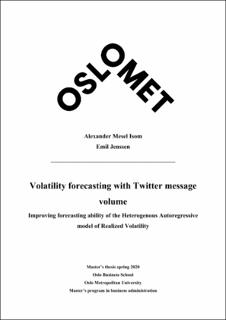Volatility forecasting with Twitter message volume - Improving forecasting ability of the Heterogenous Autoregressive model of Realized Volatility
Master thesis
Published version
Permanent lenke
https://hdl.handle.net/11250/2824006Utgivelsesdato
2020Metadata
Vis full innførselSamlinger
Sammendrag
We test the predictive power of Twitter message volume on realized volatility in a panel of 22 companies from S&P 100. The relationship is tested using OLS regression, with Newey-West standard errors. The forecasting ability of the two best performing Twitter variables is tested in models inspired by the Heterogenous Autoregressive model of Realized Volatility. We employ the Two-Scales Estimator (TSE) to achieve more precise estimates of realized volatility. TSE takes advantage of high-frequency return data, while simultaneously correcting for microstructure noise. Findings indicate a relationship between Twitter message volume and realized volatility, made most explicit by employing variables that only contain messages accumulated outside of trading hours. Twitter messages containing cashtags were found to hold greater predictive power compared to messages containing company name mentions. However, a model containing both Twitter variables were superior in terms of forecasting ability. Company name messages were found to explain systematic risk, while cashtag messages were found to explain idiosyncratic risk.
